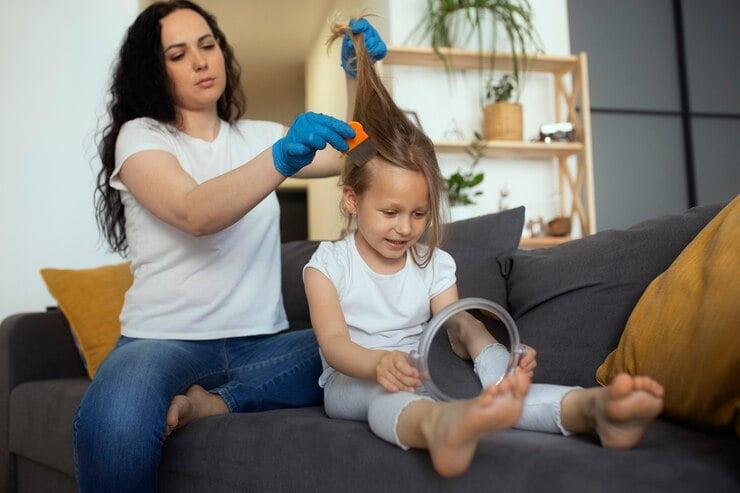|
Getting your Trinity Audio player ready...
|
Head lice infestations are common, especially among school-aged children. Embarrassment, itching, and pain may be caused by these little parasites. However, with the right approach, head lice can be effectively treated and prevented. In this comprehensive guide, we’ll explore proven treatments and prevention tips to help you say goodbye to head lice for good.
Understanding Head Lice:
Before delving into treatments and prevention strategies, it’s essential to understand what head lice are and how they spread. Insects that dwell on the scalp and feed on human blood are known as head lice. They lay eggs, known as nits, which attach to the hair shaft close to the scalp. Head lice are primarily spread through direct head-to-head contact, although they can also be transmitted through sharing personal items such as combs, brushes, hats, and headphones.
Signs and Symptoms:
Identifying head lice early is crucial for effective treatment. Infestations of head lice often manifest as:
- Persistent itching of the scalp
- Visible lice or nits on the scalp or hair
- Irritability and difficulty sleeping (due to itching)
- Small red bumps or sores on the scalp, neck, or shoulders
Proven Treatments:
Several treatments are available to eliminate head lice effectively. It’s essential to choose a treatment method based on its efficacy and safety. Here are some proven treatments for head lice:
Over-the-Counter (OTC) Medications:
Pyrethrin-based products: These are insecticides derived from chrysanthemum flowers. They work by paralyzing and killing adult lice. Examples include Rid and Pronto.
Permethrin-based products: Similar to pyrethrins, permethrin is another type of insecticide that kills lice and their eggs. Examples include Nix and Elimite.
Follow the instructions carefully when using OTC medications, and repeat the treatment if necessary to ensure all lice and nits are eliminated.
Prescription Medications:
Buy Ivermectin Cream: This prescription medication is effective against lice resistant to other treatments. The lice and their eggs are paralyzed and killed by it.
Malathion lotion: This prescription medication is applied to dry hair and left on for a specify period before rinsing. Malathion works by disrupting the lice’s nervous system.
Home Remedies:
Olive oil or coconut oil: Applying olive oil or coconut oil to the scalp and hair suffocates lice and makes it easier to comb them out.
Mayonnaise: Similar to oils, mayonnaise can suffocate lice. Apply a thick layer to the scalp and hair, cover with a shower cap, and leave on overnight before washing out.
Tea tree oil: Tea tree oil has insecticidal properties and can be dilute with water or a carrier oil and applied to the scalp to kill lice.
Wet Combing:
Wet combing involves using a fine-tooth comb to remove lice and nits from damp hair. This method may need to be repeat several times to ensure all lice and eggs are removed.
Prevention Tips:
Preventing head lice infestations requires a combination of proactive measures and ongoing vigilance. Here are some effective prevention tips:
Educate Children and Parents:
Teach children about the importance of avoiding head-to-head contact with their peers and not sharing personal items such as hats, combs, and hair accessories.
Encourage parents to regularly check their children’s hair for signs of lice, especially after potential exposure, such as sleepovers or school events.
Use Preventive Products:
Consider using lice-repellent sprays or shampoos containing natural ingredients such as tea tree oil or neem oil to help prevent infestations.
Encourage children to wear their hair up in braids, buns, or ponytails, as lice are less likely to infest hair that is pull back tightly.
Regularly Clean Personal Items:
Wash clothing, bedding, hats, and other personal items that may come into contact with the head in hot water and dry them on high heat to kill any lice or nits.
Encourage children not to share items such as hats, helmets, headphones, and hairbrushes to reduce the risk of spreading lice.
Perform Routine Head Checks:
Make routine head checks a part of your family’s grooming routine, especially if there has been a known exposure to lice. Use a fine-tooth comb to check for lice and nits regularly.
Conclusion:
Dealing with head lice can be frustrating, but with the right treatments and prevention strategies, it’s possible to eliminate infestations and reduce the risk of re-infestation. By educating yourself and your family, using effective treatments, and implementing preventive measures, you can bid farewell to head lice and enjoy a happier, lice-free life. Remember to remain vigilant and address any signs of infestation promptly to prevent the spread to others.
For More Information Here: Goodrxaustralia


